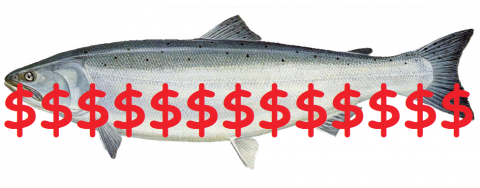You are here
Fish farm culls cost public $138m

March 18 2014 Chronicle Herald
Fish farm culls cost public $138m
SELENA ROSS STAFF REPORTER
Over two decades, at least $138million of taxpayer money has compensated Canadian fish farms for sick, culled stocks.
All the culls were in Nova Scotia, New Brunswick and Newfoundland and Labrador. Several East Coast environmental groups joined forces recently to count up the total cost of all known payouts.
The pattern in the numbers shows that disease is a built-in part of the aquaculture industry and has shown little improvement, said Raymond Plourde of the Ecology Action Centre in Halifax.
“Their model is flawed, it’s vulnerable for this and it’s time for the government to pull that system from them,” Plourde said.
The Canadian Food Inspection Agency has made some of the compensation numbers public only recently, including $13 million to Cooke Aquaculture for a 2012 cull near Shelburne.
Nell Halse, a spokeswoman for Cooke, said the company has not been a frequent recipient of compensation money and is actively advancing its farming techniques.
The Ecology Action Centre, the Fundy Baykeeper and the Conservation Council of New Brunswick relied on government statements and news reports for their tally, they said in a news release.
Between 1996 and 2006, $75 million was paid by federal and provincial governments, they said, though they did not specify which companies and provincial governments were involved.
From 2007 to now, at least $63 million has been paid, including about $43 million for six culls on the south coast of Newfoundland in 2012 and 2013.
The money discourages technological advances that are desperately needed, said Plourde.
“It’s still very early days. The industry likes to say, ‘We’ve been around for 30 years.’ Not when you’re trying to domesticate an animal and turn it into a herd animal.”
Plourde said governments should be encouraging companies like Gray Aqua Group and Cooke Aquaculture to prevent disease. He said infectious salmon anemia, the most common reason for the culls, hasn’t been adequately proven to exist in local wild fish.
“What they should do is to put some money into research and development and engineering to design … a secure biological barrier between their factory food fish production animals and the wild environment.”
Developing and using such technology would bring the costs of ocean-based farms closer to those of closed-containment onshore facilities, said Plourde.
“Viruses and parasites are part of life for all farmers,” said Halse.
After Cooke’s 2012 cull, the company absorbed losses from a second outbreak, she said. There have been no diagnoses since.
“We follow best practices and are implementing a bay management farming system that involves crop rotation and fallowing or resting of farms between crops.”
The Canadian Food Inspection Agency said in a statement that immediate disease reporting is “critical for disease control and market access,” and each case is handled individually.
Gray Aqua filed for bankruptcy protection last summer.

Copyright APES 2012 Website by Ionsign Online

